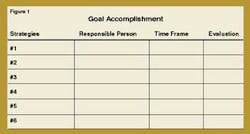by Cathy Jameson, PhD
My definition of a great dental team is "a group of leaders working cohesively toward a common set of goals." According to my definition, each team member is a leader. Each person is responsible for supporting other members of the team and helping their colleagues to maximize their potential. Each can build up the other members of the team — or tear them apart. Each team member also has a role in leading patients to make decisions. That's why in today's sophisticated dental world, a strong team is essential.
What can you do to create and maintain a productive, healthy team? Numerous elements are involved in team-building. In this two-part series, I will define critical areas of teamwork that need to be integrated into your practice.
Vision
Start here. Make sure that your entire team is clear about the vision of your practice. Define the vision and start down the path to making that vision a distinct reality. The vision is the overall view of your "ideal practice." What does that look like to you? Refuse to accept anything less than your ideal. There is absolutely no reason to compromise!
Goals
Once you have a clearly written and acknowledged vision, begin work on the specifics. How are you going to make that vision become a reality? Goal-setting and goal accomplishment are, really, other words for strategic business planning. Here is where you integrate solid principles of business management into your practice's development.
Goals become the defined plan of action set forth with the intention of accomplishing predetermined results. Your goals must be written down. "That which cannot be monitored cannot be measured."
What follows is a guide for your strategic planning. We developed this guide for my husband's practice and have used it in every one of our client's practices since then. Please use this form. Use it during any strategic- planning session or in any team meeting. Give a copy of each individual plan to members of the team who are involved with a project. Post any project that is in an active state of work where all can see it. Or, keep a three-ring binder of each plan so that you can review those plans at your team meetings. (See Figure 1: Goal Accomplishment)
If you asked your team what the goals for your practice are, could they answer that question? Do you have goals set for each of the critical factors within the business of your practice? Is everyone clear about those goals? Are you monitoring your success and making adjustments quickly and effectively if these goals are not being met?
Remember, goal-setting is an important blueprint for your success.
Surround yourself with superstars
Yes, you are — or can be — a superstar and so can each person on your team. Dr. William James, the father of American psychology, says that the average person uses only 5 to 10 percent of his or her potential. All of us have talent and potential that are untapped, unnurtured, and unused. So, as a team of leaders, be in the business of helping the other members of your team "unfold" in your environment.
Hire slowly ... and hire right! Work with experts in management consulting or in human resources to learn the very intricate skills of seeking, interviewing, hiring, orienting, training, and retaining quality team members. One of the reasons that there is so much turnover in the dental profession is because the hiring and training were not done well in the first place.
When you are seeking a new team member, skill level and expertise are valuable and essential for certain roles, such as hygiene. However, management experts will tell you that skills and expertise are not the only factors that need to be considered if a successful team is to be developed. Most difficulties — and even failures within teams — don't come from a lack of expertise and skill. Rather, they come from conflict among team members, poor leadership, and a lack of involvement and/or commitment from team members.
As you are selecting team members, consider the following:
• Is this person willing to share his or her talent and expertise with others?
• Does this person like working in/with a group or does this individual prefer to work alone?
• Is this person a good communicator? Can he or she get ideas across? Is he or she willing to listen to another point of view?
• Can you count on this person to complete responsibilities/tasks in an expedient and excellent fashion?
• Will this person be able to support the ideas and projects of the team?
• Is this individual willing to help another team member — even if it is with something that is not a part of his or her responsibility?
Establish position responsibilities
A smooth-running operation has carefully established systems in place and qualified people administering those systems. Team members must know what is expected of them if they are to have confidence and success in their work and your practice is to run smoothly and effectively. Define the role responsibilities of each position and of each person administering that position. You must have a person "ultimately responsible" for each system. Then, create monitors to make sure that each system is functioning productively.
Don't be afraid to develop position responsibilities because of a concern that people will not be willing to chip in and help each other. If that happens, you don't have a team. Dr. Ken Blanchard says, "You never hear 'that's not my job' on a high performing team." If you have that kind of selfish, self-centered behavior occurring in your practice, you need to access some team- development assistance or determine the source of the problem. Then, hire people who understand, believe in, and are willing to work toward ultimate teamwork.
As you create your position responsibilities (or job descriptions), make sure that you do more than write a list of activities to be performed. Outline the "key responsibilities" and focus on end results. As you write these valuable descriptions, be sure that the most important word of all appears on each one. That word is "crossover." A team is an amalgamation of individuals who are willing and able to support one another no matter what. If you don't have that kind of willing interaction, you don't have a team. And, without a solid team, your practice will be stifled until you make a decision to alter the situation.
Put the plan into action
Now you have a clear vision of what you want to accomplish. You have a proven method of accomplishing your goals in your hands. You have a great team who is clear about its responsibilities. Now the question is, are you ready to put your plans into action? Are you ready to follow through with the excellent ideas and strategic plans that you have created? Is your team willing to hold itself and each other accountable for carrying out their individual and group assignments?
If yes, then you are in great shape and the action is ready to happen. However, you can do all the planning in the world, but if you don't carry out those plans, you must ask, "Who are we kidding? Do we really expect things to change or develop if we are not ready and willing to do everything that we agreed upon?"
Team meetings
Great businesses have great meetings! Hold excellent team meetings. Make sure that you schedule time to communicate with each other. There is no reason to go to the trouble of developing great plans for progress if you do not follow through on them. Trying to make decisions or evaluate progress between patients or while you are running down the hall is unacceptable. Schedule time when everyone on the team can sit down — uninterrupted — to focus on practice development. This is essential for continuous growth and progress.
Your team meetings need to be productive, dynamic, and fruitful. The following criteria will help you hold effective team meetings:
1. Schedule the meetings well in advance. Let everyone know those times.
2. Have an agenda in everyone's hands the day before the meeting.
3. Start on time and stop on time.
4. Begin with the most important issues. Work to a conclusion and then move on. (Remember to use the five-step, goal-accomplishment form during these meetings to record your decisions.)
5. Determine a set amount of time for each item and move succinctly through the discussion.
6. Have a facilitator (not the doctor) and a recorder.
7. Make sure everyone is prepared to participate.
8. Review the critical statistics of the practice.
9. Evaluate projects that are in progress.
10.Be constantly on a path of improvement.
Accountability
By developing a plan of action, by committing to "action," and by holding effective team meetings, you will be well on your way to a critical concept of teamwork: accountability! In order to develop a great team and get things done in a timely and effective manner, each member of the team must be able to count on every other member of the team. After all, that's what teamwork is all about!
Once you are working on a project and have developed and agreed upon individual responsibilities, accountability becomes essential. If you develop a plan for a project, everyone must fulfill his or her responsibility in a timely fashion. If one person fails, then another team member is hampered or prevented from fulfilling her responsibility. Like a chain, the team is only as strong as its weakest link.
To be effective, each team member must:
• Do what he or she has agreed to do.
• Reach out and help other members of the team if help is needed. Be willing to "crossover."
• Follow up on any activities that are related to the project and give updates and reports on the status of any activity.
• Bring problems or challenges out in the open.
• Create an atmosphere where team members can express their concerns or any confusion. If people think they will be criticized for making mistakes or embarrassed in front of others for not being able to do something, they will become discouraged, make mistakes, and then try to cover them up. At that point, it will be too late to prevent problems.
Remember that the last step of goal accomplishment is to evaluate. I really do believe that this is one of the most important steps. When you are evaluating your progress on any project or activity, do the following:
1) As you complete a task that lies within the overall plan of action, evaluate your progress. Make sure to note the things that are going well and point out the things that need continuous development.
2) If you are "off course," step back and honestly and carefully determine what is going on. If the goal you are working toward is still desirablel, but you find that your plan of action isn't working, please don't continue on that path! Step back. See what is working. Do more of that. See what isn't working. Change it. You know the definition of insanity: "Doing the same thing and expecting a different result."
Nurturing the team
In this, the first of a two-part series, I have outlined some vital aspects of creating and nurturing the dental dream team. As I stated at the outset, this entire subject — team-building and team development — is intricate. Nothing will ever be more important to you if you truly want to improve your practice, accelerate your productivity, control your stress, or create your ideal practice.
That said, I think you will agree with me that nothing may be more difficult, more trying, more challenging — and, on the other hand — more fulfilling. When you are surrounded by people with whom you love sharing the days; when you know that you can count on someone to lend a helping hand or get something done in a timely fashion; and when you feel respected and valued, you will love coming to work.
In Part 2, I will address six more factors related to creating and nurturing your team. Please keep these articles in your file for reference. Start now. Go over the material in this first article. Have open, honest discussions with your staff. Discover ways to improve, refine, and further develop your team in each of the areas we discussed. Then, go back and revisit these principles from time to time to celebrate your accomplishments or to continue on your path of improvement.
Here's to building your dental dream team!
Five Steps to Goal-SettingFollow a simple, but effective, five-step process for accomplishing your goals:1. Write the goal. Dr. Ken Blanchard says that you need to make sure that your goals are S.M.A.R.T.S = specific
M = motivational
A = attainable
R = relevant
T = trackable2. Design the plan of action. Outline the strategies for accomplishing the goal. What are you going to do, how are you going to do it, why is each step of the plan essential? Identify any resources you will need and identify any barriers that might be getting in your way. 3. Determine who will do what. Assign a person or persons the responsibility of carrying out each step of the plan.4. Assign a time frame for each step of the plan.5. Evaluate your progress. Monitor your plan to see if it is working. Make any alterations that might help you to accomplish your goal more effectively.







